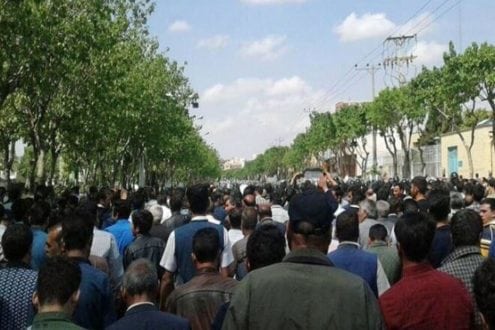Al-Arabia – When the poor people in a nation has nothing to lose and starvation forces them to look for food in bins while critics of their oppressor are met with brutal repression, neither bullets nor mass arrests can stop them from protesting against the status quo.
At a time when masses only see a dark future for themselves and their families, any organized opposition effort to tear down the wall of repression will foster a culture of resistance and give courage to the silent majority to join the starving protesters on the streets.
When the affluent ruling class is riddled with corruption and the ruling system can no longer deceive people because of growing internal conflicts among the political establishment and is unable to reinstate the atmosphere of fear by its security organs because of losing ideological leverage, a real change in favor of the poor class is inevitable.
ANALYSIS: New US sanctions bring new challenges for Iranian regime
The above is the very definition of a revolutionary situation in a society.
However, when there also exists a determined popular resistance movement to overthrow the authoritarian system, no powers, no cunning opportunists nor behind the scene deals can provide the ruling class with security guarantees and ensure their survival by stopping the change whose time has come.
Such is the situation today in Iran’s society.
What makes this wave of demonstrations different is that the people have finally had enough of being robbed by the ruling regime and decided to come out on the streets
Hamid Bahrami
Reforming the republic
Discussions over reforming the Islamic Republic has dominated the Iran debate for nearly two decades. But this illusion only resulted in a destroyed country with constant state attacks on the civil liberties and fundamental rights of the citizens, faltering economy, high suicide rate (due to social and economic difficulties) and environmental crisis.
Earlier this year, poor and starving Iranians rose up against the regime in at least 100 major and small cities across the country despite the authorities responding with bullets to their legitimate demands. At the time, the middle class did not join them because of the high risks associated with dissent.
Now in the hot Iranian summer, a different scenario is being played out on streets of Iran. Voice of America reported last week that “anti-government protests by Iranians fed up with their nation’s economic woes have spread to 10 major cities … these protests are yet to be dispersed”.
ALSO READ: Washington restores tough, unilateral Iran sanctions lifted under nuclear deal
What makes this wave of demonstrations different is that the people have finally had enough of being robbed by the ruling regime and decided to come out to the streets.
Hassan, an employee of the Sepah bank in Isfahan whose last name is not provided because of security reason, tells me that, “until last year, my family and I could afford living expenses if I worked hard and economized but this is now impossible. This is while our money is being spent in Syria and Iraq or is being stolen by officials and their children”.
“I did not attend the nationwide protests last January because I thought that was not my problem but now middle-class citizens like me are rapidly becoming poorer”, he adds.
I have heard similar stories from dozen others like Hassan and most of them say they will be forced to take the risk and join other protesters if the situation does not change.
Brutal crackdown
The Iranian regime’s brutal crackdown shows that it is unable to address and deliver on the legitimate demands of the people on the street.
Now, one could argue that a revolutionary situation with popular protesters on the streets needs an organized opposition movement and strong leadership who are able to articulate the demands of the poor and middle class into a clear roadmap for success.
These crucial ingredients for success is provided by the opposition coalition the National Council of Resistance of Iran (NCRI), and its main organized constituent, the People’s Mojahedin Organization of Iran (PMOI/MEK), among the various Iranian opposition groups.
Both the MEK and the NCRI have spearheaded the struggle against the Iranian regime for a free, democratic and secular Iran for the last 40 years and are the opposition most feared by the regime’s Supreme Leader and officials.
ALSO READ: Iran’s Rouhani dismisses Trump call for talks on eve of new sanctions
These days the MEK is organizing anti-regime protests through its network inside Iran and help the people to break through the brutal crackdown of the Revolutionary Guards (IRGC) forcing the Supreme Leader and other senior officials to acknowledge this reality publicly.
Losing the domestic struggle to the forces of democratic change, the Iranian regime is now desperate to deflect the crisis by provoking a controlled military tension in the region.
Considering the situation on Iran’s streets, the Trump administration should not fall in the theocracy’s trap as the clerics are looking for ways to secure their survival and instead continue to support the protesters on the streets in Iran as Secretary Pompeo did recently in his speech to the Iranian-American community.
_______________________
Hamid Bahrami is a former political prisoner from Iran who now resides in Glasgow, Scotland. He is a human right and political activist and works as a freelance journalist. He tweets at @HaBahram and blogs at analyzecom.
Last Update: Thursday, 9 August 2018 KSA 15:14 – GMT 12:14
Disclaimer: Views expressed by writers in this section are their own and do not reflect Al Arabiya English’s point-of-view.
 Shabtabnews In this dark night, I have lost my way – Arise from a corner, oh you the star of guidance.
Shabtabnews In this dark night, I have lost my way – Arise from a corner, oh you the star of guidance.



